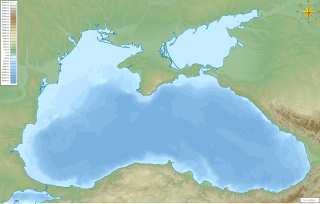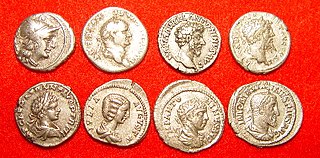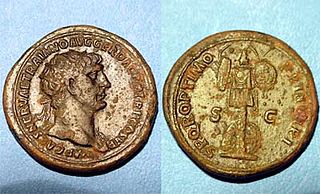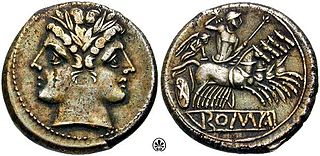The libral standard compares the weight of coins to the bronze as , which originally weighed one Roman pound, but decreased over time to 1/2 pound (the semi-libral standard). It is often used in discussions of ancient cast coinage of central Italy, especially Etruscan coins and Roman Republican coinage. The adjective libral is related to libra, the Ancient Roman unit of weight, and is not related to the word liberal .
A coin is a small, flat, round piece of metal or plastic used primarily as a medium of exchange or legal tender. They are standardized in weight, and produced in large quantities at a mint in order to facilitate trade. They are most often issued by a government.

The as, occasionally assarius was a bronze, and later copper, coin used during the Roman Republic and Roman Empire.

The ancient Roman units of measurement were largely built on the Hellenic system, which in turn was built upon Egyptian and Mesopotamian influences. The Roman units were comparatively consistent and well documented.
The libral standard began with the era of the so-called aes grave (heavy bronze) cast coinage of Rome, from circa 280 BC, where one as weighed one Roman pound (libra), or twelve Roman ounces (unciae). This changed when the weight of the aes grave was decreased to approximately 10 unciae (the "light libral standard") circa 265-217 BC, remaining at that level until about 217 BC. It then suddenly fell to 6 unciae (the "semi-libral standard") around the start of the second Punic war in about 217 BC, before finally falling still further until about 141 BC. [1]
Aes grave is a term in numismatics indicating bronze cast coins used in central Italy during the 3rd century BC, whose value was generally indicated by signs: I for the as, S for semis and pellets for unciae. Standard weights for the as were 272, 327, or 341 grams, depending upon the issuing authority.
The libral/semi-libral standards were followed by the triental standards and the sextantal standard.
Many Greek city states (colonies) were founded on the Italian peninsula and Sicily during this time period; these are collectively referred to as Magna Graecia. The coinage of those city-states is more closely related to the rest of the ancient Greek world (which included many colonies along the Mediterranean and Black Sea coasts), and generally has no relationship to the Etruscan/Roman units.

Magna Graecia was the name given by the Romans to the coastal areas of Southern Italy in the present-day regions of Campania, Apulia, Basilicata, Calabria and Sicily; these regions were extensively populated by Greek settlers, particularly the Achaean settlements of Croton, and Sybaris, and to the north, the settlements of Cumae and Neapolis. The settlers who began arriving in the 8th century BC brought with them their Hellenic civilization, which was to leave a lasting imprint on Italy, such as in the culture of ancient Rome. Most notably the Roman poet Ovid referred to the south of Italy as Magna Graecia in his poem Fasti.

The Black Sea is a body of water and marginal sea of the Atlantic Ocean between the Balkans, Eastern Europe, the Caucasus, and Western Asia. It is supplied by a number of major rivers, such as the Danube, Dnieper, Southern Bug, Dniester, Don, and the Rioni. Many countries drain into the Black Sea, including Austria, Belarus, Bosnia and Herzegovina, Bulgaria, Croatia, Czech Republic, Georgia, Germany, Hungary, Moldova, Poland, Romania, Russia, Serbia, Slovakia, Slovenia, Turkey and Ukraine.











